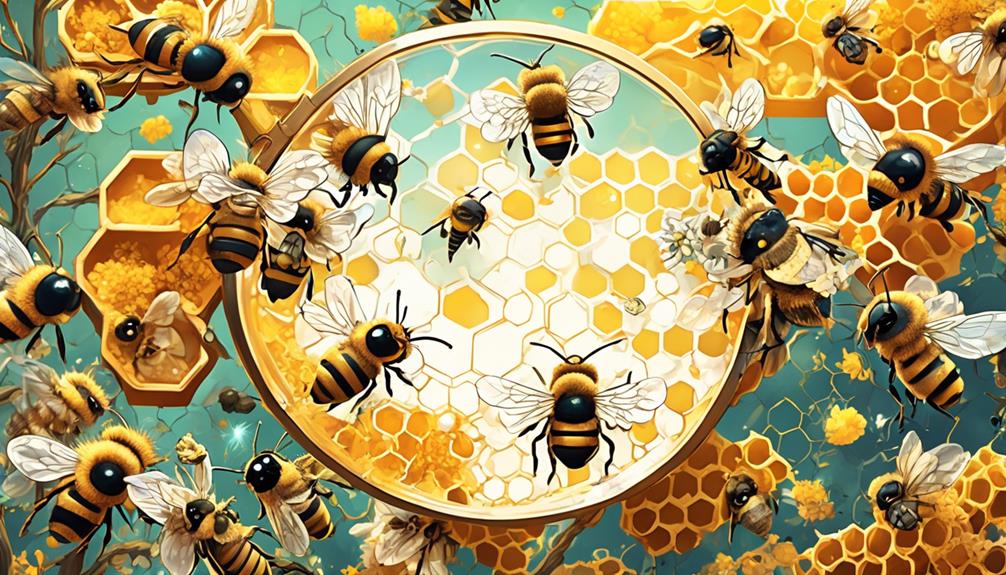Observe the mysterious world of Mason bees and the enigmatic effects of Colony Collapse Disorder on their population.

Are Mason Bees Affected by Ccd
Imagine a world without bees, a quiet planet where flowers bloom, but no buzzing breaks the silence. It's a scenario you'd not want to entertain, isn't it?
Colony Collapse Disorder, or CCD, has been causing quite a stir in the world of beekeeping, with honeybees disappearing from hives without a trace. The impact of this disorder on the honeybee population is heartbreaking, but have you ever wondered how CCD affects other bee species, specifically Mason bees?
Let's plunge into this enigma, and you might find the revelations quite intriguing.
Key Takeaways
- Mason Bees are solitary creatures that construct their own nests and are efficient pollinators.
- While Mason Bees may be relatively resilient to Colony Collapse Disorder (CCD) due to their solitary lifestyle, they are still susceptible to other threats such as parasitic mites, viruses, and pesticide exposure.
- The environmental changes triggered by CCD, such as a decrease in flowering plants caused by honeybee loss, could indirectly affect Mason Bees by impacting their food sources.
- Diversifying gardens with native plants, opting for pesticide-free plants, providing safe habitats for Mason Bees, supporting local beekeepers, and advocating for policies that protect pollinators are important measures to help protect Mason Bees from the ripple effects of CCD.
Understanding Colony Collapse Disorder

To understand Colony Collapse Disorder, you must first grasp the intricate dynamics that govern a bee colony's health and survival. Imagine a well-oiled machine: each cog and gear plays a crucial role. In a bee colony, each member has a specific task and all tasks are essential. The queen, drones, and worker bees all contribute to the hive's harmony and efficiency.
Now, let's dissect Colony Collapse Disorder or CCD. It's a phenomenon where the majority of worker bees in a colony disappear, leaving behind a queen, plenty of food, and a few nurse bees to care for the remaining immature bees. The cause of CCD isn't fully understood yet, but it's likely a combination of factors including pathogens, pesticides, and environmental stressors.
You'd think that with the queen and food still present, the colony could recover. But it's not that simple. The worker bees aren't just the colony's labor force, they're also the colony's defenders and foragers. Without them, the colony can't sustain itself. So, despite the remaining resources, the colony inevitably collapses. Understanding this gives you insight into the complexity and fragility of bee colonies and the devastating impact of CCD.
Mason Bees: A Brief Overview

Now, let's delve into the world of Mason Bees, a group of species whose unique characteristics and behaviors set them apart in the bee kingdom. These bees are solitary creatures, meaning that unlike honeybees, they don't live in large colonies. Instead, each female constructs her own nest, usually in hollow stems or pre-existing holes in wood. They've earned their name from their habit of using mud or clay—like a mason—to build partitions within their nests.
Mason Bees are revered for their efficiency as pollinators. Research shows that they're far more productive than honeybees, which makes them crucial components of our ecosystem. These bees aren't aggressive and rarely sting, making them a perfect choice for urban and suburban environments.
Despite their significance, Mason Bees face various threats, including habitat loss and climate change. However, their solitary lifestyle might provide them with a degree of protection against Colony Collapse Disorder (CCD) that decimates honeybee populations. Understanding the biology and behavior of Mason Bees is vital to conservation efforts and ensuring the vitality of our ecosystems.
Impact of CCD on Honeybees

While Mason Bees may be somewhat shielded from the effects of CCD, honeybees aren't so fortunate. CCD, or Colony Collapse Disorder, is a devastating phenomenon threatening honeybee populations globally. You see, honeybees aren't just your average insect. They're vital pollinators, crucial for the sustainability of many ecosystems and agricultural industries.
Let's take a closer look at the impact of CCD on honeybees:
Impact | Description |
|---|---|
Population decline | CCD can cause sudden, unexplained losses in honeybee colonies, leading to significant declines in population. |
Reduced pollination | A decrease in honeybee numbers means less pollination. This threatens biodiversity and food production. |
Economic consequences | Honeybees contribute billions to the global economy through pollination services. Their loss could lead to serious economic consequences. |
CCD's causes are still under investigation, but it's clear that its effects on honeybees are dire. As a beekeeper, farmer, or concerned citizen, it's crucial you're aware of this issue and its implications. By understanding the impact of CCD, you can better contribute to efforts mitigating its effects and fostering honeybee health.
Investigating CCD's Effect on Mason Bees

Despite the relative resilience of Mason Bees, it's essential to delve into how CCD might impact this species, in order to fully grasp the potential reach of this devastating disorder. Unlike honeybees, Mason Bees are solitary creatures, each female independently building her own nest. This behavior could potentially insulate them from the widespread damage CCD inflicts on highly social bee colonies.
However, it's crucial to remember that Mason Bees, like their honeybee counterparts, are also susceptible to parasitic mites, viruses, and pesticide exposure, all of which are implicated in CCD. Thus, it's not beyond reason to suspect that CCD could, indirectly, affect Mason Bees as well.
Moreover, the impact of CCD on Mason Bees mightn't be as direct as it's on honeybees, but the environmental changes triggered by CCD could still pose a significant threat. For instance, if CCD decimates honeybee populations, the resultant pollination deficit could lead to a decrease in the number and diversity of flowering plants, which Mason Bees rely on for food.
Therefore, while Mason Bees mightn't directly succumb to CCD in the same way honeybees do, they're not completely impervious to its ripple effects.
Possible Solutions and Preventive Measures

To safeguard both Mason Bees and honeybees from the potential ravages of CCD, it's imperative to explore and implement a range of solutions and preventive measures. You can play a crucial role in this endeavor.
Firstly, diversifying your garden with a wide array of native plants can contribute to the overall health and vigor of bee populations. It's essential to opt for pesticide-free plants, as these chemicals are known to exacerbate CCD. Also, providing a safe habitat for Mason Bees can help. Consider installing a bee house in your yard, ensuring it's clean and free from parasites.
Secondly, supporting local beekeepers and honey producers can indirectly combat CCD. These individuals often employ sustainable practices, which contribute to the well-being of bees.
Lastly, engaging in citizen science projects and advocacy can make a significant difference. By reporting sightings of Mason Bees and other pollinators, you contribute to vital research tackling CCD. Advocacy for policies that protect pollinators and restrict harmful pesticides is also necessary.
Frequently Asked Questions
What Are the Main Differences Between Mason Bees and Honey Bees?
You're looking at two different bee species here.
Mason bees, solitary and non-aggressive, don't produce honey but are incredible pollinators. They nest in pre-existing holes, hence the name.
Honey bees, however, live in large colonies, produce honey, and can be defensive. They're also good pollinators, but not as efficient as mason bees.
Basically, the main differences lie in their social structure, nesting habits, and honey production.
Can Mason Bees Produce Honey Like Honey Bees?
No, you can't expect mason bees to produce honey like honey bees. Mason bees are solitary creatures; they don't live in colonies and don't produce honey.
They're primarily pollinators, not honey producers. They collect nectar for their own consumption and carry pollen on their bellies to fertilize flowers.
Are There Any Other Threats to Mason Bees Aside From Ccd?
Yes, there are other threats to Mason bees aside from CCD.
Pesticide exposure, habitat loss, and climate change are significant issues.
Pesticides can poison bees, reducing their populations.
Loss of natural habitats due to urban development disrupts their nesting and foraging.
Climate change also affects their seasonal behaviors.
It's vital to address these threats to protect Mason bees, your little garden helpers.
How Can the General Public Contribute to the Conservation of Mason Bees?
You can contribute to mason bee conservation in several ways.
- Planting native flowers provides food, while leaving patches of bare soil allows them to nest.
- You can also install bee houses in your garden.
- Pesticide use should be limited, as it's harmful to them.
- Participating in citizen science projects helps researchers gather data on these bees.
- Lastly, spreading awareness about the importance of mason bees is a key step in their protection.
How Different Are the Behaviors of Mason Bees Compared to Honeybees?
You'll notice quite a few differences between mason bees and honeybees.
Mason bees are solitary, laying their eggs in individual cells, while honeybees live in large colonies.
Mason bees also don't produce honey, and their stinger can't penetrate human skin.
Unlike honeybees, mason bees aren't aggressive and they don't swarm.
They're excellent pollinators, often more efficient than honeybees, making them valuable for agriculture and home gardens.
Conclusion
So, you've discovered that CCD, while devastating to honeybees, doesn't seem to impact mason bees in the same drastic way.
However, this doesn't mean mason bees are immune to other environmental threats.
It's crucial for us to continue researching and implementing preventive measures to protect all bees.
After all, these little pollinators play a huge role in keeping our ecosystems and food supplies thriving.
Let's keep digging deeper.
We owe it to the bees, and ourselves.



